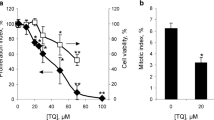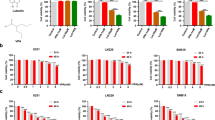Abstract
Temozolomide (TMZ) is an oral alkylating agent that has been widely used in the treatment of refractory glioma, although inherent and acquired resistance to this drug is common. The clinical use of valproic acid (VPA) as an anticonvulsant and mood-stabilizing drug has been reported primarily for the treatment of epilepsy and bipolar disorder and less commonly for major depression. VPA is also used in the treatment of glioma-associated seizures with or without intracranial operation. In this study, we evaluated the potential synergistic effect of TMZ and VPA in human glioma cell lines. Compared with the use of TMZ or VPA alone, concurrent treatment with both drugs synergistically induced apoptosis in U87MG cells as evidenced by p53 and Bax expression, mitochondrial transmembrane potential loss, reactive oxygen species production, and glutathione depletion. This synergistic effect correlated with a decrease in nuclear translocation of the nuclear factor-erythroid 2 p45-related factor and corresponded with reduced heme oxygenase-1 and γ-glutamylcysteine synthetase expression. Pretreatment with N-acetylcysteine partially recovered the apoptotic effect of the TMZ/VPA combination treatment. The same degree of synergism is also seen in p53-mutant Hs683 cells, which indicates that p53 may not play a major role in the increased proapoptotic effect of the TMZ/VPA combination. In conclusion, VPA enhanced the apoptotic effect of TMZ, possibly through a redox regulation mechanism. The TMZ/VPA combination may be effective for treating glioma cancer and may be a powerful agent against malignant glioma. This drug combination should be further explored in the clinical setting.








Similar content being viewed by others
References
Papait R, Magrassi L, Rigamonti D, Cattaneo E (2009) Temozolomide and carmustine cause large-scale heterochromatin reorganization in glioma cells. Biochem Biophys Res Commun 379:434–439
Batista LF, Roos WP, Kaina B, Menck CF (2009) p53 mutant human glioma cells are sensitive to UV-C-induced apoptosis due to impaired cyclobutane pyrimidine dimer removal. Mol Cancer Res 7:237–246
Lena A, Rechichi M, Salvetti A, Bartoli B, Vecchio D, Scarcelli V, Amoroso R, Benvenuti L, Gagliardi R, Gremigni V, Rossi L (2009) Drugs targeting the mitochondrial pore act as cytotoxic and cytostatic agents in temozolomide-resistant glioma cells. J Transl Med 7:13
Guillard S, Clarke PA, Te Poele R, Mohri Z, Bjerke L, Valenti M, Raynaud F, Eccles SA, Workman P (2009) Molecular pharmacology of phosphatidylinositol 3-kinase inhibition in human glioma. Cell Cycle 8:443–453
Huang XJ, Li CT, Zhang WP, Lu YB, Fang SH, Weir EQ (2008) Dihydroartemisinin potentiates the cytotoxic effect of temozolomide in rat C6 glioma cells. Pharmacology 82:1–9
Gupta V, Su YS, Wang W, Kardosh A, Liebes LF, Hofman FM, Schönthal AH, Chen TC (2006) Enhancement of glioblastoma cell killing by combination treatment with temozolomide and tamoxifen or hypericin. Neurosurg Focus 20:E20
Sabayan B, Foroughinia F, Chohedry AA (2007) Postulated role of garlic organosulfur compounds in prevention of valproic acid hepatotoxicity. Med Hypotheses 68:512–514
Kawai Y, Arinze IJ (2006) Valproic acid-induced gene expression through production of reactive oxygen species. Cancer Res 66:6563–6569
Lin CT, Lai HC, Lee HY, Lin WH, Chang CC, Chu TY, Lin YW, Lee KD, Yu MH (2008) Valproic acid resensitizes cisplatin-resistant ovarian cancer cells. Cancer Sci 99:1218–1226
Lucke JF (1996) Student’s t test and the Glasgow coma scale. Ann Emerg Med 28:408–413
Azmi AS, Wang Z, Burikhanov R, Rangnekar VM, Wang G, Chen J, Wang SFH, Mohammad RM (2008) Critical role of prostate apoptosis response-4 in determining the sensitivity of pancreatic cancer cells to small-molecule inhibitor-induced apoptosis. Mol Cancer Ther 7:2884–2893
Bhattacharyya A, Lahiry L, Mandal D, Sa G, Das T (2005) Black tea induces tumor cell apoptosis by Bax translocation, loss in mitochondrial transmembrane potential, cytochrome c release and caspase activation. Int J Cancer 117:308–315
Zhu H, Cao Z, Zhang L, Trush MA, Li Y (2007) Glutathione and glutathione-linked enzymes in normal human aortic smooth muscle cells: chemical inducibility and protection against reactive oxygen and nitrogen species-induced injury. Mol Cell Biochem 301:47–59
Ong PL, Weng BC, Lu FJ, Lin ML, Chang TT, Hung RP, Chen CH (2008) The anticancer effect of protein-extract from Bidens alba in human colorectal carcinoma SW480 cells via the reactive oxidative species- and glutathione depletion-dependent apoptosis. Food Chem Toxicol 46:1535–1547
Wang XJ, Sun Z, Villeneuve NF, Zhang S, Zhao F, Li Y, Chen W, Yi X, Zheng W, Wondrak GT, Wong PK, Zhang DD (2008) Nrf2 enhances resistance of cancer cells to chemotherapeutic drugs, the dark side of Nrf2. Carcinogenesis 29:1235–1243
Liu L, Trimarchi JR, Keefe DL (1999) Thiol oxidation-induced embryonic cell death in mice is prevented by the antioxidant dithiothreitol. Biol Reprod 61:1162–1169
Shieh DE, Liu LT, Lin CC (2000) Antioxidant and free radical scavenging effects of baicalein, baicalin and wogonin. Anticancer Res 20:2861–2865
Yap KY, Chui WK, Chan A (2008) Drug interactions between chemotherapeutic regimens and antiepileptics. Clin Ther 30:1385–1407
Oberndorfer S, Piribauer M, Marosi C, Lahrmann H, Hitzenberger P, Grisold W (2005) P450 enzyme inducing and non-enzyme inducing antiepileptics in glioblastoma patients treated with standard chemotherapy. J Neurooncol 72:255–260
Campàs C, Lopez JM, Santidrián AF, Barragán M, Bellosillo B, Colomer D, Gil J (2003) Acadesine activates AMPK and induces apoptosis in B-cell chronic lymphocytic leukemia cells but not in T lymphocytes. Blood 101:3674–3680
Luo W, Liu J, Li J, Zhang D, Liu M, Addo JK, Patil S, Zhang L, Yu J, Buolamwini JK, Chen J, Huang C (2008) Anti-cancer effects of JKA97 are associated with its induction of cell apoptosis via a Bax-dependent and p53-independent pathway. J Biol Chem 283:8624–8633
Meijerman I, Beijnen JH, Schellens JH (2008) Combined action and regulation of phase II enzymes and multidrug resistance proteins in multidrug resistance in cancer. Cancer Treat Rev 34:505–520
Lau A, Villeneuve NF, Sun Z, Wong PK, Zhang DD (2008) Dual roles of Nrf2 in cancer. Pharmacol Res 58:262–270
Kweon MH, Adhami VM, Lee JS, Mukhtar H (2006) Constitutive overexpression of Nrf2-dependent heme oxygenase-1 in A549 cells contributes to resistance to apoptosis induced by epigallocatechin 3-gallate. J Biol Chem 281:33761–33772
Nowis D, Bugajski M, Winiarska M, Bil J, Szokalska A, Salwa P, Issat T, Was H, Jozkowicz A, Dulak J, Stoklosa T, Golab J (2008) Zinc protoporphyrin IX, a heme oxygenase-1 inhibitor, demonstrates potent antitumor effects but is unable to potentiate antitumor effects of chemotherapeutics in mice. BMC Cancer 8:197
Kalinina EV, Chernov NN, Saprin AN, Kotova YN, Andreev YA, Solomka VS, Scherbak NP (2006) Changes in expression of genes encoding antioxidant enzymes, heme oxygenase-1, Bcl-2, and Bcl-xl and in level of reactive oxygen species in tumor cells resistant to doxorubicin. Biochemistry (Mosc) 71:1200–1206
Chen GG, Liu ZM, Vlantis AC, Tse GM, Leung BC, van Hasselt CA (2004) Heme oxygenase-1 protects against apoptosis induced by tumor necrosis factor-alpha and cycloheximide in papillary thyroid carcinoma cells. J Cell Biochem 92:1246–1256
Iida T, Kijima H, Urata Y, Goto S, Ihara Y, Oka M, Kohno S, Scanlon KJ, Kondo T (2001) Hammerhead ribozyme against gamma-glutamylcysteine synthetase sensitizes human colonic cancer cells to cisplatin by down-regulating both the glutathione synthesis and the expression of multidrug resistance proteins. Cancer Gene Ther 8:803–814
Nagata J, Kijima H, Hatanaka H, Asai S, Miyachi H, Takagi A, Miwa T, Mine T, Yamazaki H, Nakamura M, Kondo T, Scanlon KJ, Ueyama Y (2001) Reversal of cisplatin and multidrug resistance by ribozyme-mediated glutathione suppression. Biochem Biophys Res Commun 286:406–413
Marchetti P, Decaudin D, Macho A, Zamzami N, Hirsch T, Susin SA, Kroemer G (1997) Redox regulation of apoptosis: impact of thiol oxidation status on mitochondrial function. Eur J Immunol 27:289–296
Hall AG (1999) Review: the role of glutathione in the regulation of apoptosis. Eur J Clin Investig 29:238–245
Pias EK, Aw TY (2002) Apoptosis in mitotic competent undifferentiated cells is induced by cellular redox imbalance independent of reactive oxygen species production. FASEB J 16:781–790
Acknowledgments
This work was supported by grant NSC 96-2320-B-415-002-MY3 (C.-H. Chen) from the National Science Council and grant CMRPG 660071 from the Chang Gung Medical Research Council, Taiwan, Republic of China.
Disclosure statement
The authors report no potential conflict of interest relevant to this article.
Author information
Authors and Affiliations
Corresponding author
Rights and permissions
About this article
Cite this article
Chen, CH., Chang, YJ., Ku, M.S.B. et al. Enhancement of temozolomide-induced apoptosis by valproic acid in human glioma cell lines through redox regulation. J Mol Med 89, 303–315 (2011). https://doi.org/10.1007/s00109-010-0707-1
Received:
Revised:
Accepted:
Published:
Issue Date:
DOI: https://doi.org/10.1007/s00109-010-0707-1




